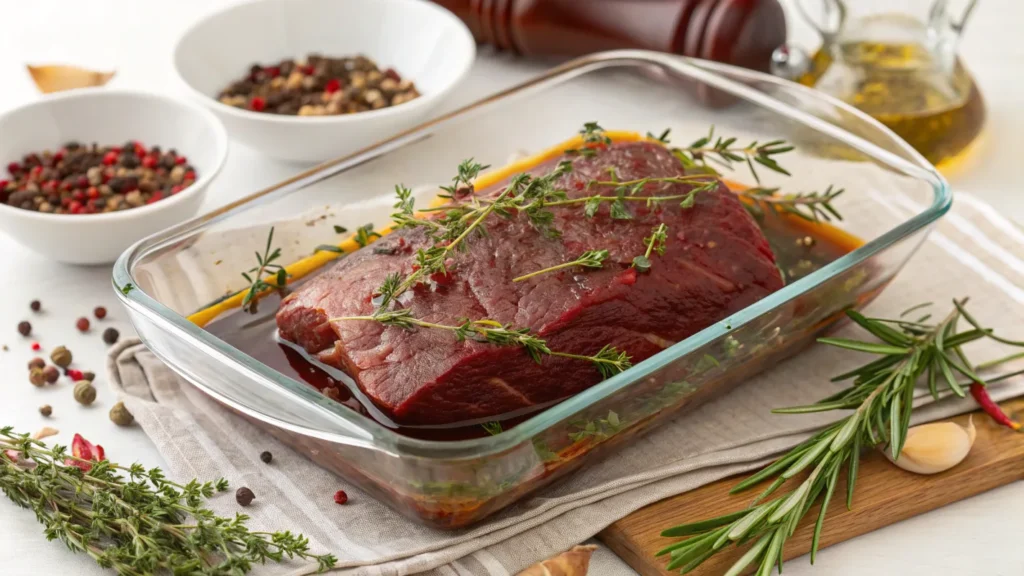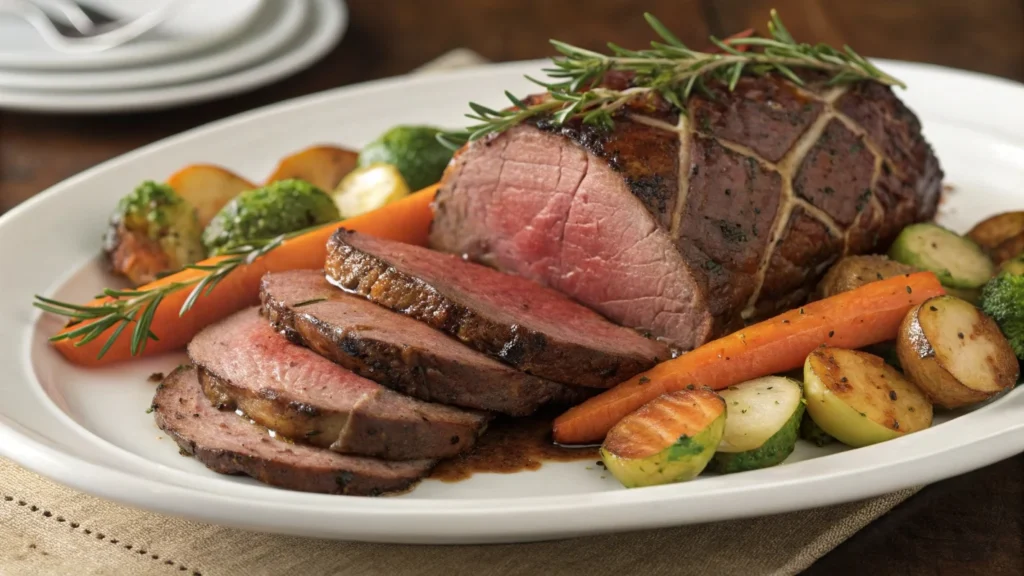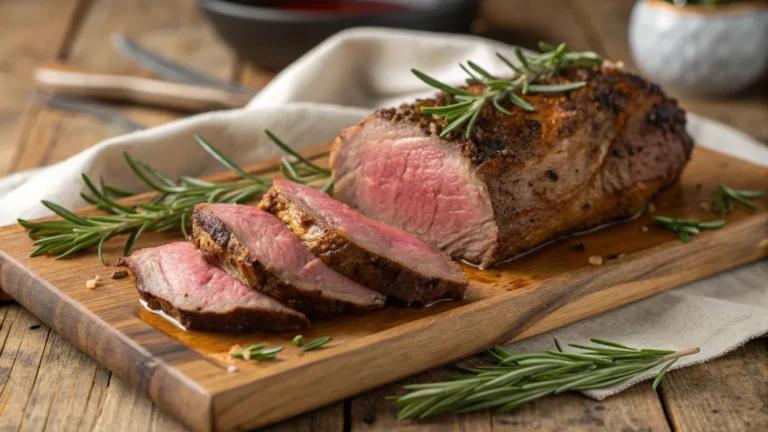Venison Roast Recipe: The delicately flavored meat of deer is a prized ingredient for hearty and satisfying meals. While some shy away from cooking venison due to its reputation for being tricky, this guide will show you how easy it is to prepare a tender, juicy venison roast. Packed with expert tips, tried-and-tested methods, and delicious pairings, this article will transform your game-cooking skills.
Let’s go into the secrets of crafting the perfect venison roast, from preparation and marination to cooking and serving. Whether you’re a seasoned chef or a beginner, this recipe will leave your taste buds wanting more.
Table of Contents
Introduction to Cooking the Perfect Venison Roast
What is Venison Roast?
Venison roast is a cut of deer meat that is ideal for slow cooking or roasting. Typically leaner than beef or pork, venison has a slightly gamey flavor and a tender texture when cooked properly. Cuts like the shoulder, hindquarter, or loin are commonly used for roasting.
Why Choose Venison for Your Meals?
Venison is a healthier alternative to traditional red meats. It boasts higher protein content, lower fat levels, and an array of essential vitamins like iron and B12. It is also a sustainable option, making it a favorite among eco-conscious consumers and foodies.
The Art of Cooking Venison: An Overview
Cooking venison to perfection requires balancing its lean nature with the proper preparation techniques. Every step, from marinating to choosing the ideal cooking method, contributes to a tender and flavorful roast.
Are you looking for creative ways to enhance your recipes? Please explore our Complete Guide to Creative Recipes for tips on taking your dishes to the next level.
Preparing Your Venison Roast: The Essential Steps
How to Select the Best Cut for a Venison Roast
The first step in creating a delectable venison roast is choosing the proper cut. Opt for cuts like:
- Shoulder: Perfect for slow cooking due to its connective tissue, which breaks down to create a melt-in-your-mouth texture.
- Hindquarter (rump): Ideal for roasting, as it’s tender with minimal marbling.
- Login or tenderloin: Premium cuts with a delicate flavor are best for quick roasting.
When buying venison, ensure it is fresh or adequately aged. Look for dark red meat with minimal fat and no strong odor.
Cleaning and Trimming Tips for Game Meat
Venison often retains a thin silverskin—a membrane that should be removed before cooking to avoid chewiness. Use a sharp knife to carefully trim the silverskin and any excess fat, which can contribute to a gamey taste.
Soaking Venison: Why and How to Do It
Soaking venison is a game-changer for tenderizing the meat and mellowing the gamey flavor. Standard soaking methods include:
- Milk or Buttermilk: Neutralizes gamey notes and softens the meat.
- Vinegar and Water Mixture: Adds mild acidity to break down fibers.
- Red Wine Marinade: A flavorful option that enhances the richness of venison.
To soak, fully submerge the meat in your chosen liquid in the refrigerator for 4–12 hours. Pat it dry before marinating or cooking.

Ingredients YoYou’lleed for the Ultimate Venison Roast
Essential Ingredients for Flavorful Results
You use a mix of staples and seasonings to create a mouthwatering venison roast. Here’s a list of essentials:
- Venison roast: Approximately 3-4 pounds.
- Salt and pepper: For basic seasoning.
- Garlic cloves (4-5): Minced for aromatic flavor.
- Onions (2 large): Sliced to enhance the natural sweetness of the dish.
- Carrots (3-4): Chopped for a hearty accompaniment.
- Celery (2 stalks): Adds depth and earthiness.
- Potatoes (optional): Great for a one-pan meal.
- Beef or venison broth: This keeps the roast moist during cooking.
Optional Herbs and Spices to Elevate Your Dish
Take your venison roast to the next level by adding aromatic herbs and spices. Consider:
- Fresh rosemary and thyme: Perfect for infusing herbal notes.
- Bay leaves: For a subtle, complex flavor.
- Paprika: Adds warmth and a hint of smokiness.
- Juniper berries (crushed): A traditional complement to game meat.
Stock or Broth Choices for Moisture Retention
Using a high-quality broth is critical to ensuring a moist and tender roast. Options include:
- Venison broth: If available, this enhances the natural gamey taste.
- Beef broth: A standard alternative that blends well with venison.
- Chicken broth: For a lighter flavor profile.
When preparing the ingredients, chop your vegetables into even pieces to ensure they cook uniformly with the roast.
Step-by-Step Guide to Cooking Venison Roast
Marinating the Venison Roast for Maximum Tenderness
Marinating is crucial for tenderizing venison and infusing it with bold flavors. Here to do it:
- Prepare the Marinade: Combine olive oil, minced garlic, fresh herbs (rosemary and thyme), salt, pepper, and a splash of red wine or balsamic vinegar.
- Soak the Roast: Place the venison in a large, sealable bag or container, then pour the marinade over it.
- Refrigerate: Allow it to marinate for 4–12 hours, turning occasionally to ensure even coverage.
How Long Should You Roast Venison?
The cooking time for venison depends on the size of the roast and your desired doneness:
- Rare: 130–135°F internal temperature (approximately 15–20 minutes per pound).
- Medium-Rare: 135–140°F (20–25 minutes per pound).
- Well-Done: 155–160°F (30 minutes per pound), though this is not recommended as venison can dry out.
Temperature Control and Timing: The Key to Perfection
- Preheat Your Oven: Set to 325°F for even, gentle cooking.
- Sear the Roast: Heat a skillet with oil on high and sear all sides of the roast until browned. This locks in juices and adds a rich, caramelized flavor.
- Prepare the Baking Dish: Layer onions, carrots, celery, and potatoes in a baking dish. Pour 1–2 cups of broth over the vegetables to moisten them.
- Roast the Venison: Place the seared roast on the vegetables, cover tightly with foil, and roast.
- Monitor Internal Temperature: Use a meat thermometer to avoid overcooking.
Tip: Baste the roast every 30 minutes with pan juices for added moisture.
Final Touches Before Serving
- Rest the Meat: Remove the venison from the oven and let it rest, covered, for 10–15 minutes. This redistributes the juices, ensuring a moist roast.
- Slice Against the Grain: Carve the roast into thin slices against the grain for the most tender bites.
Discover how ingredient substitutions can transform your recipes in our Ingredient Swap Guide.
Pro Tips for Keeping Your Venison Roast Moist and Tender
Using a Meat Thermometer for Accurate Results
A meat thermometer is your best friend when cooking venison. Since venison is lean, even a slight overcooking can result in dryness. Follow these tips:
- Insert the Thermometer: Place it in the thickest part of the roast, avoiding bones or fat.
- Check Regularly: Monitor the temperature as the roast nears the estimated cooking time to prevent overcooking.
- Target Temperatures:Rare: 130–135°F
- Medium-Rare: 135–140°F
- Medium: 145–150°F
Best Cooking Methods: Slow Cooking vs. Quick Roasting
Choosing the proper cooking method depends on your preference and time:
- Slow Cooking: This method is ideal for trickier cuts like the shoulder or shank. Slow cooking at low heat (225°F) for several hours tenderizes connective tissues.
- Quick Roasting: This method is best for tender cuts like loin or tenderloin. A higher heat setting (325°F–350°F) for a shorter time preserves the natural juiciness.
Looking for inspiration? Try our Slow Cooker Secrets for tenderizing game meat effortlessly.
Covering and Resting the Meat for Juiciness
To lock in moisture:
- Cover the Roast: Use foil or a lid while roasting to trap steam, preventing the meat from drying.
- Add Moisture: Place a shallow pan of water or broth at the bottom of the oven to create a humid environment.
- Rest Before Serving: After roasting, let the venison rest under foil for 10–15 minutes. This process allows the juices to redistribute throughout the meat, ensuring every slice is succulent.
Additional Tips for Moist Venison
- Baste Regularly: Use the pan juices every 20–30 minutes for added flavor and moisture.
- Use Fat for Extra Flavor: Wrap the roast in bacon or add butter to the marinade for richness.
- Don’t skip the Marinade: Soaking the roast in a marinade helps tenderize the meat and enhances the flavor.
Serving Suggestions for Your Venison Roast
What Sides Pair Best with Venison Roast?
A well-cooked venison roast deserves equally delicious accompaniments. Here are some side dishes that complement the rich and earthy flavors of venison:
- Roasted Vegetables: Carrots, parsnips, Brussels sprouts, and sweet potatoes roasted with olive oil, garlic, and herbs.
- Creamy Mashed Potatoes: Classic mashed potatoes seasoned with butter, cream, and a pinch of nutmeg.
- Wild Rice Pilaf: A nutty and aromatic side that balances the gamey flavor of venison.
- Red Cabbage Slaw: Adds a tangy and refreshing crunch to your plate.
Tip: A drizzle of balsamic glaze over roasted vegetables brings out their natural sweetness and pairs beautifully with venison.

Presentation Tips to Impress Your Guests
A visually appealing plate enhances the dining experience. Here to plate your venison roast like a pro:
- Slice Thinly: Arrange thin slices of venison roast in a fanned-out design on the plate.
- Add a Pop of Color: Garnish with fresh herbs like rosemary or parsley for a vibrant touch.
- Serve Family-Style: Place the roast on a rustic wooden platter surrounded by roasted vegetables for a warm, inviting appearance.
Ideas for Leftovers: Transforming Roast into New Dishes
Don’t let any part of your roast go to waste! Use leftovers to create:
- Venison Sandwiches: Layer thin slices of venison with arugula, cranberry sauce, and mustard on crusty bread.
- Hearty Stews: Combine leftover roast with diced potatoes, carrots, and onions in a savory broth.
- Tacos or Wraps: Shred the venison and serve in tortillas with fresh salsa and avocado.
Common Mistakes to Avoid When Cooking Venison
Overcooking or Undercooking: Finding the Balance
One of the most common pitfalls when cooking venison is overcooking, which results in a dry, rugged texture. On the other hand, undercooking venison can leave the meat chewy and unappetizing.
- Solution: Use a meat thermometer to ensure the perfect internal temperature. Stick to the target range for your desired doneness (rare to medium-rare).
Skipping the Marination Process
Neglecting to marinate venison is a missed opportunity to enhance flavor and tenderize the meat—the lean nature of venison benefits greatly from soaking in a well-balanced marinade.
- Solution: Marinate for at least 4 hours or overnight for best results. Choose a marinade with an acid (like vinegar or citrus) to break down tough fibers.
How to Avoid Dry and Gamey Tastes
The gamey taste and dry texture often associated with venison are usually the result of improper handling or preparation.
- Solution: Remove silverskin and excess fat before cooking to minimize gamey flavors.
- Avoid cooking venison beyond medium doneness.
- Use moist cooking methods, like braising or slow roasting, to retain moisture.
Forgetting to Rest the Meat
Cutting into a venison roast immediately after cooking causes the juices to escape, leaving the meat dry.
- Solution: After removing the roast from the oven, allow it to rest, covered, for 10–15 minutes. This step ensures that the juices redistribute evenly throughout the meat.
Not Pairing with the Right Ingredients
VeVenison’snique flavor can be overshadowed or poorly complemented by mismatched sides or sauces.
- Solution: Pair venison with earthy vegetables, tangy fruits like cranberries, and rich gravies for a harmonious meal.
FAQs
1. How long should I roast venison for?
The cooking time for venison depends on the weight of the roast and the desired doneness. As a general rule:
Rare: 15–20 minutes per pound (130–135°F).
Medium-Rare: 20–25 minutes per pound (135–140°F).
Well-Done: 30 minutes per pound (155–160°F), though well-done venison may become dry.
Tip: Use a meat thermometer for accuracy and avoid overcooking.
2. How do you cook venison so it’s tender?
The cooking time for venison depends on the weight of the roast and the desired doneness. As a general rule:
Rare: 15–20 minutes per pound (130–135°F).
Medium-Rare: 20–25 minutes per pound (135–140°F).
Well-Done: 30 minutes per pound (155–160°F), though well-done venison may become dry.
Tip: Use a meat thermometer for accuracy and avoid overcooking.
3. What do you soak a deer roast in before cooking?
Soaking venison helps neutralize the gamey taste and tenderizes the meat. Popular soaking liquids include:
Milk or buttermilk.
A mix of water and vinegar.
Red wine or a wine-based marinade.
Soak for 4–12 hours in the refrigerator for the best results.
4. How to keep venison roast from drying out?
Cover the roast with foil while cooking to trap steam.
Baste with pan juices every 20–30 minutes.
Use a moist cooking method, like braising, or add broth to the baking dish.
5. Is it better to cook venison fast or slow?
Fast cooking: Suitable for tender cuts like loin or tenderloin.
Slow cooking: Ideal for tougher cuts such as shoulder or shank, as it breaks down connective tissue.
6. How do you get the gamey taste from a deer roast?
Remove the silverskin and excess fat, as these hold a much gamey flavor.
Marinate the roast with acidic ingredients like vinegar or citrus.
Soak in milk or buttermilk to mellow the taste.
Benefits of Cooking and Eating Venison
Nutritional Benefits of Venison Meat
Venison is a nutritional powerhouse and an excellent alternative to traditional red meats. ItIt’sacked with:
- Lean Protein: Venison is naturally lower in fat than beef or pork, making it a nutritious option for those looking to support a balanced and healthy diet.
- Rich in Vitamins and Minerals: It is endowed with iron, zinc, and B vitamins (B6 and B12), which support energy production and immune health.
- Low in Calories: Despite being nutrient-dense, venison has fewer calories per serving than other meats.
Venison vs. Traditional Meats: A Healthier Choice
When compared to traditional meats like beef and lamb, venison stands out as a healthier option:
- Lower Saturated Fat: Venison contains less unhealthy fat, reducing the risk of heart disease.
- No Added Hormones: Most venison comes from wild or free-range sources, making it a more natural option.
- High Omega-3 Content: Omega-3s help improve brain health and reduce inflammation, especially in grass-fed deer.
Sustainability and Ethical Hunting Practices
Choosing venison also supports sustainable eating practices:
- Environmental Impact: Deer are wild game, so farming resources like land, water, and feed are minimized.
- Population Management: Hunting helps control deer populations, preventing overpopulation that can damage ecosystems.
- Local Sourcing: Venison is often sourced locally, reducing the carbon footprint associated with transportation.
Why Venison is a Culinary Delight
Beyond its health and environmental advantages, venison provides a distinct culinary journey, offering rich flavors and a tender texture that set it apart from more common meats:
- Flavor Profile: Its mildly gamey and earthy flavor pairs beautifully with bold marinades and rich sauces.
- Versatility: From roasts to stews, venison adapts well to various cooking techniques.
- Special Occasions: VeVenison’s unique taste makes it perfect for holiday or celebratory dinners.
Conclusion and Final Tips
Cooking a venison roast may seem daunting, but with the proper techniques and preparation, it can be a culinary masterpiece. Every step contributes to a tender, juicy, and flavorful result, from selecting the perfect cut and marinating it to ensuring accurate cooking temperatures. Whether you’re preparing it for a special occasion or simply exploring new recipes, venison roast is a delightful addition to your menu.
Final Tips for the Best Venison Roast Recipe
- Invest in a Meat Thermometer: This ensures precise cooking and prevents overcooking.
- DoDon’tkip the Marinade: A good marinade enhances flavor and tenderizes the meat.
- Rest Before Slicing: Allow the roast to rest after cooking to retain its juices.
- Pair Thoughtfully: Serve venison with complementary sides like roasted vegetables or wild rice.
Venison roast isn’t just a meal—it’s an experience that brings rich flavors, nutritional benefits, and a touch of elegance to your table. With this guide, you’ll be ready to create a dish that’s sure to impress.
Please don’t use our RECIPES for more creative ways.

